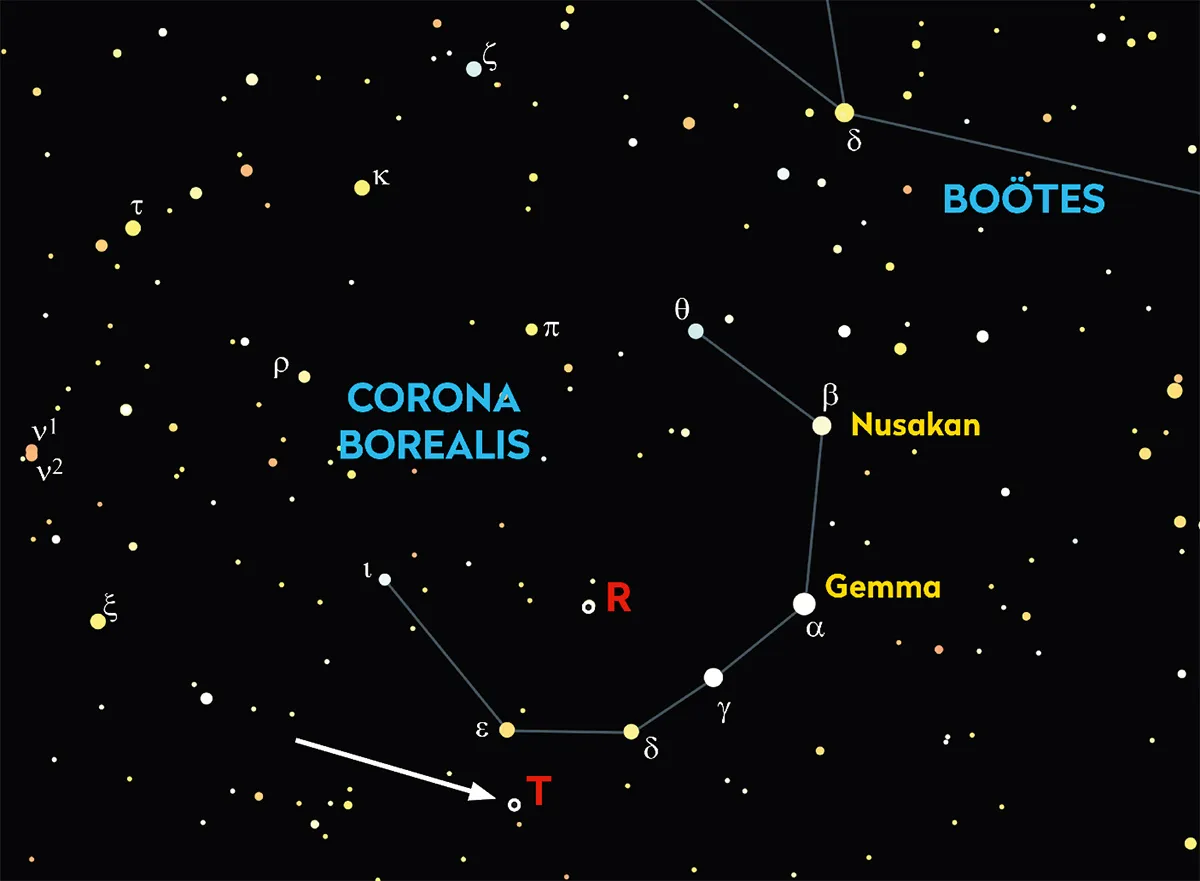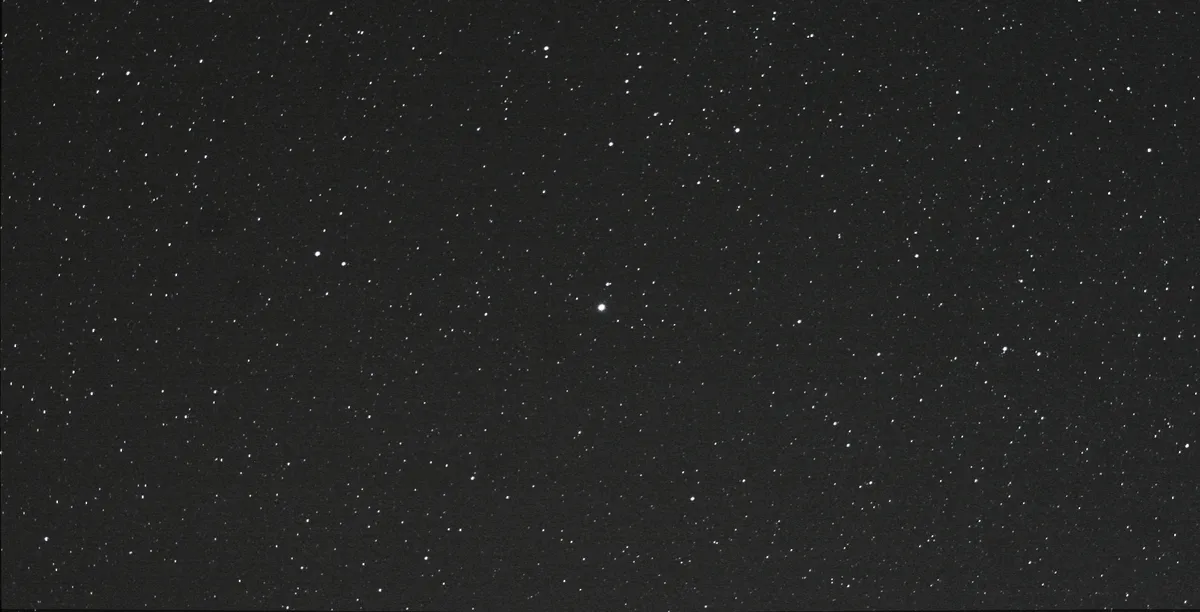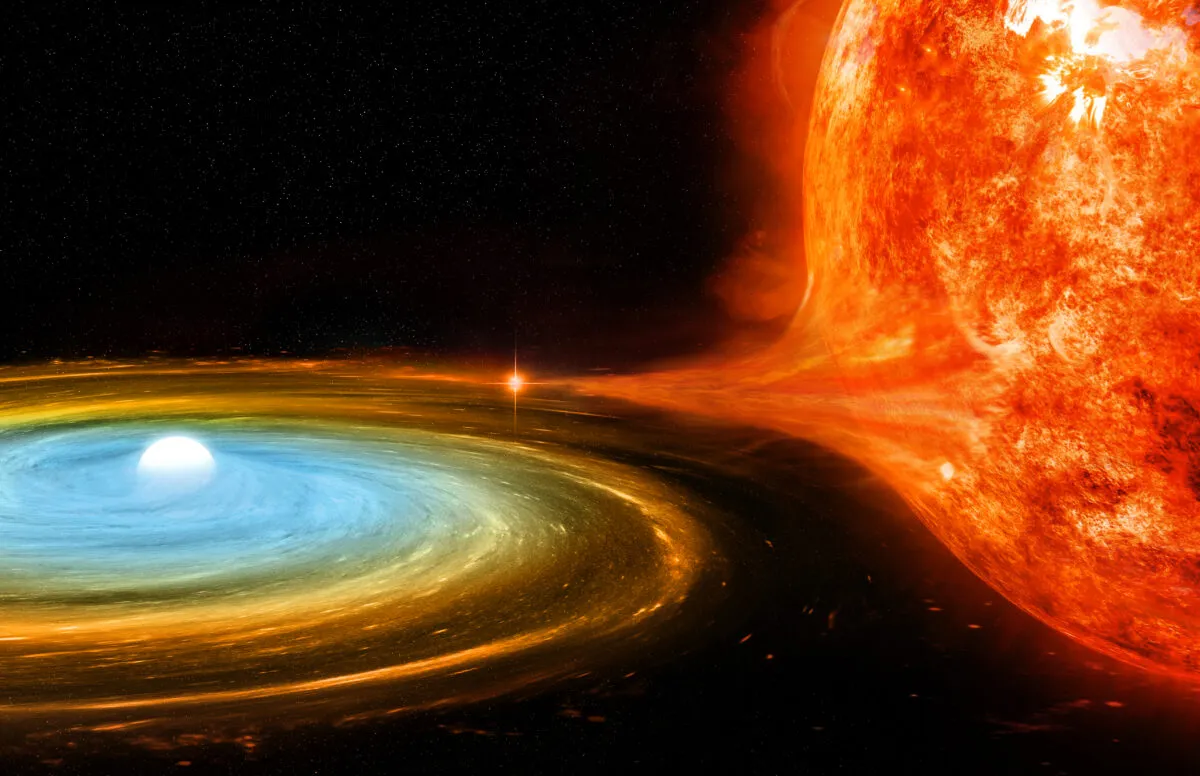A star system 3,000 lightyears away known as the 'Blaze Star' is set to become visible to the naked eye, shining like a 'new star' in the sky.
T Coronae Borealis, also known as T CrB or the 'Blaze Star', last brightened in 1946, and astronomers initially predicted it would brighten again by September 2024.
As of mid-2025, T Coronae Borealis, the Blaze Star, hasn't exploded yet, but when it does happen, its apparent brightness will temporarily increase.
The Blaze Star is a variable star in Corona Borealis, the Northern Crown, a backward-C-shaped constellation east of Boötes.
Astronomers are keeping an eye on T Coronae Borealis for that predicted brightening.

Will the Blaze Star brighten soon?
Astronomers expect T Coronae Borealis, the Blaze Star, could brighten any time soon. One astronomer even predicted that 27 March 2025 might be the day.
Writing in a paper published by the American Astronomical Society, Jean Schneider predicted the next eruption could happen 27 March 2025, 10 November 2025, or later.
"The investigation is based on the combination of the previous eruption dates and on the orbital ephemeris of the binary system, without any hypothesis on the eruption mechanism," the paper says.
"Since the last eruption was in 1946, a new eruption is expected soon, from weeks to a few months."
But, as we know, that date has now passed and the Blaze Star still hasn't erupted.

Why the Blaze Star will brighten
T CrB is a recurring nova, a star that brightens due to an interaction between two stars in a binary system, one a red giant and one a white dwarf.
'Nova' means 'new star' in Latin, so-called because it describes how a previously dim star can suddenly reach prominent naked-eye brightness in the sky.
Material accretes from the red giant onto the white dwarf, until enough mass has transferred to set off a thermonuclear detonation.
This causes T CrB to brighten significantly, possibly as bright as second magnitude.
That brightness is on a par with the North Star, Polaris (Alpha (α) Ursae Minoris) and Gemma (Alpha (α) Coronae Borealis).
Gemma isn’t far from T CrB, 1° south-southeast of mag. +4.1 Epsilon (ε) Coronae Borealis. If the backward C pattern looks a little ‘off’, then the outburst is under way.

What the T Coronae Borealis nova will look like
Star system T Coronae Borealis normally shines at a brightness of magnitude +10.
'Magnitude' is the value astronomers use to describe the relative brightness of one celestial object, as it appears from Earth, compared to others.
On the magnitude scale, the higher the number, the dimmer the object.
Sirius, the brightest star in the night sky, has a magnitude of -1.46, for example. The full Moon has a magnitude of about -13.

T Coronae Borealis is expected to jump to magnitude +2 during the nova event, which would make it similar in brightness to the North Star, Polaris.
It could be visible to the naked eye for several days and potentially visible for over a week through binoculars.
It will then dim again and could remain inactive for another 80 years, making this a potential once-in-a-lifetime astronomical event.
Prepare now to see the T Coronae Borealis nova

Keep an eye on astronomy websites and follow @NASAUniverse on X for news of the brightening T Coronae Borealis nova event.
The nova will appear in the constellation Corona Borealis, which appears as a small semicircle near the constellations Boötes and Hercules.
Boötes can be found by locating the Plough star pattern in the sky. Follow the 'handle' of the Plough away from the asterism and you'll arrive at Boötes.
Then look to the left of Boötes and you'll see Corona Borealis.

You can use an astronomy and stargazing app to help you locate the constellation, too.
Start observing Corona Borealis now and get familiar with its position in the sky. Then when the nova appears, you'll be ready to spot it.
If you are an astrophotographer, you could begin a project to photograph the Corona Borealis constellation regularly over the coming months, then you'll have a record of the nova's appearance and changing brightness over time.

What is a nova?
A nova is not the same as a supernova.
A supernova occurs when a massive star explodes at the end of its life, having run out of fuel.
A nova, on the other hand, is the temporary brightening of a star before it fades again.
T Coronae Borealis is a recurring nova, meaning it temporarily becomes thousands of times brighter. It was last seen doing so in 1946.
It's a binary star system, meaning the 'star' is really two stars orbiting each other.

T Coronae Borealis consists of a white dwarf and a red giant. A white dwarf is the dense remnant of a star that has used up all its fuel.
As the red giant begins to increase in temperature and shed its outer layers into space, the dense white dwarf companion pulls in that stellar material.
This causes the white dwarf to heat up, producing the increased brightness that we see as a nova from Earth.
"What’s happening in the system is that the red giant star is dumping all of this material onto the surface of the white dwarf," said William Cooke, NASA’s meteoroid environment programme manager, when speaking with the BBC.
"When too much gets on the surface of the white dwarf, you literally get a thermonuclear reaction, like a bomb."

How scientists know when T Coronae Borealis will brighten
By precisely measuring the amount of matter it takes for this to happen, and the rate that it is accumulating on the white dwarf, astronomers originally predicted that the next explosion would occur between February and September 2024.
That, of course, didn't happen.
"We know that before it goes nova it dims for about a year," says Cooke. "T Coronae Borealis started dimming back in March 2023."
The star is usually mag. +10.0 and only visible through a telescope, but the nova is expected to increase its brightness to mag. +2.0, comparable to Polaris, the North Star.
When it brightens, it should remain naked-eye visible for several days and visible in binoculars for about a week following.
You can keep watch for yourself by looking to the constellation of Corona Borealis, between Boötes and Hercules.
First recorded sighting
Words: Chris Lintott

You’ll need to know the sky well to spot the upcoming eruption of T CrB, which makes it all the more remarkable that its first recorded sighting dates back to the 13th century.
In autumn 1217, Burchard, abbot of Ursberg, Germany, recorded "a faint star that for a time shone with great light".
Admittedly, he also says there was “a very bright ray reaching up into the sky, like a large, tall beam”, which doesn’t sound like T CrB, but medieval writers often confused atmospheric phenomena like aurorae with celestial events.
I’ll definitely try to catch T CrB this time around, and when I do I’ll be thinking of the observant abbot, looking up at the same star over 800 years ago.
If you manage to observe or photograph the T Coronae Borealis nova, let us know by emailing us at contactus@skyatnightmagazine.com


